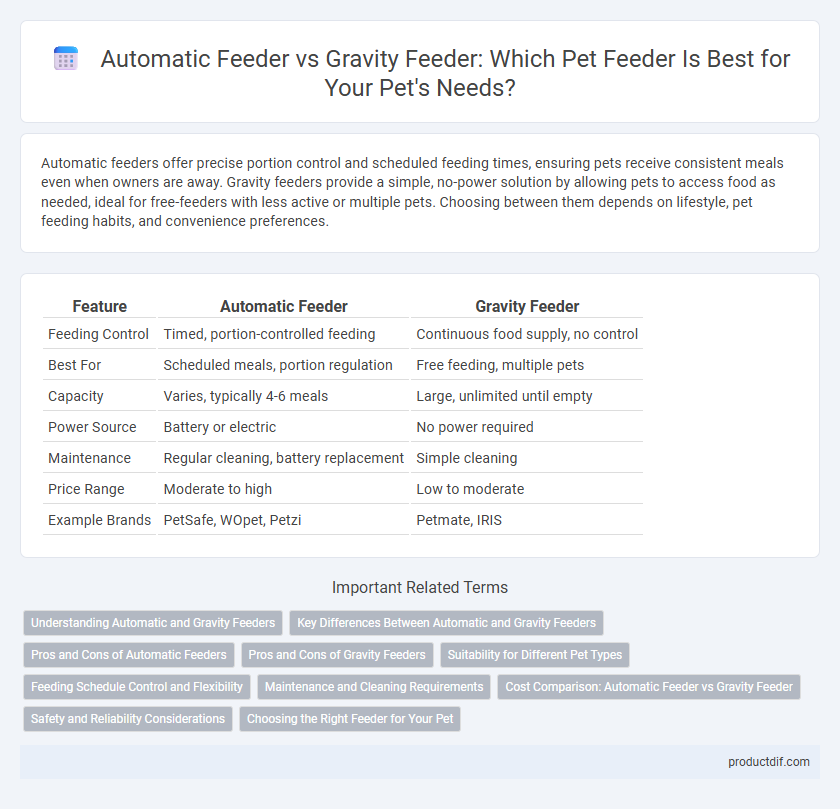Automatic feeders offer precise portion control and scheduled feeding times, ensuring pets receive consistent meals even when owners are away. Gravity feeders provide a simple, no-power solution by allowing pets to access food as needed, ideal for free-feeders with less active or multiple pets. Choosing between them depends on lifestyle, pet feeding habits, and convenience preferences.
Table of Comparison
| Feature | Automatic Feeder | Gravity Feeder |
|---|---|---|
| Feeding Control | Timed, portion-controlled feeding | Continuous food supply, no control |
| Best For | Scheduled meals, portion regulation | Free feeding, multiple pets |
| Capacity | Varies, typically 4-6 meals | Large, unlimited until empty |
| Power Source | Battery or electric | No power required |
| Maintenance | Regular cleaning, battery replacement | Simple cleaning |
| Price Range | Moderate to high | Low to moderate |
| Example Brands | PetSafe, WOpet, Petzi | Petmate, IRIS |
Understanding Automatic and Gravity Feeders
Automatic feeders use programmable timers and portion control to dispense food at scheduled intervals, ensuring consistent feeding for pets. Gravity feeders rely on a reservoir that fills the bowl as the pet eats, providing a continuous supply of food without electronic components. Understanding the differences helps pet owners choose between precise meal portions and convenience for free-feeding.
Key Differences Between Automatic and Gravity Feeders
Automatic feeders dispense precise portions of pet food at scheduled times, ensuring consistent meal sizes and preventing overfeeding, while gravity feeders rely on the natural pull of gravity to refill the bowl as pets eat, allowing continuous access to food without portion control. Automatic feeders often feature programmable timers and portion size settings, ideal for pets needing controlled diets, whereas gravity feeders are simpler, low-maintenance options suited for pets that can self-regulate their eating. The primary difference lies in feeding control and timing precision, with automatic feeders offering enhanced management compared to the basic refill mechanism of gravity feeders.
Pros and Cons of Automatic Feeders
Automatic feeders offer precise portion control and scheduled feeding times, reducing the risk of overfeeding and promoting consistent pet nutrition. They require electricity or batteries and may malfunction, potentially disrupting feeding schedules or causing missed meals. While ideal for busy pet owners, automatic feeders need regular maintenance and monitoring to ensure reliable operation.
Pros and Cons of Gravity Feeders
Gravity feeders offer a simple, cost-effective solution for pet feeding, automatically replenishing food as pets eat without the need for electricity or programming. Their low maintenance and reliability make them ideal for pet owners seeking convenience, but they lack portion control, potentially leading to overeating and food wastage. Limited customization and dependence on gravity can result in inconsistent feeding schedules, which may not suit pets with specific dietary needs.
Suitability for Different Pet Types
Automatic feeders offer precise meal portions and scheduled feeding times, making them ideal for pets requiring controlled diets such as cats, small dogs, and pets with health issues. Gravity feeders work well for smaller pets or those that eat frequently, like puppies or rabbits, providing constant access to food without portion restrictions. Selecting the right feeder depends on pet size, eating habits, and dietary needs to ensure proper nutrition and prevent overeating.
Feeding Schedule Control and Flexibility
Automatic feeders offer precise feeding schedule control with programmable timers and portion settings, ensuring pets receive meals at consistent intervals. Gravity feeders provide minimal flexibility, releasing food as the pet eats without regulating meal frequency or portions. For pet owners seeking tailored feeding routines and portion management, automatic feeders deliver superior customization compared to gravity feeders.
Maintenance and Cleaning Requirements
Automatic feeders require regular battery checks and electronic component cleaning to ensure consistent operation, while gravity feeders demand frequent refilling and thorough cleaning to prevent food clumping and mold growth. Gravity feeders are easier to dismantle and wash, often needing daily attention to maintain hygiene, whereas automatic feeders typically have detachable parts that can be cleaned weekly. Choosing between them depends on the owner's willingness to perform routine maintenance versus occasional inspections of mechanical parts.
Cost Comparison: Automatic Feeder vs Gravity Feeder
Automatic feeders typically cost between $40 and $150, offering precise portion control and programmable feeding schedules, which can justify the higher price for pet owners seeking convenience and accuracy. Gravity feeders are more budget-friendly, usually priced between $10 and $30, but lack automated features and require manual refills, making them suitable for pet owners prioritizing simplicity and low cost. The initial investment in an automatic feeder often offsets potential long-term savings by reducing food waste, whereas gravity feeders incur less upfront expense but may lead to inconsistent feeding amounts.
Safety and Reliability Considerations
Automatic feeders offer precise portion control and scheduled feeding, reducing risks of overfeeding and ensuring consistent nutrition, which enhances pet safety. Gravity feeders provide a continuous food supply but may lead to overeating or contamination if pets spill food or pests access the bowl. Evaluating feeder reliability involves considering material durability, ease of cleaning, and power source stability to maintain safe and hygienic feeding environments.
Choosing the Right Feeder for Your Pet
Selecting the right feeder for your pet depends on factors like your pet's eating habits and lifestyle. Automatic feeders offer precise portion control and scheduled feeding times, ideal for pets requiring consistent meals or owners with busy schedules. Gravity feeders provide a simple, continuous food supply but may lead to overeating if not monitored carefully.
Automatic Feeder vs Gravity Feeder Infographic

 productdif.com
productdif.com